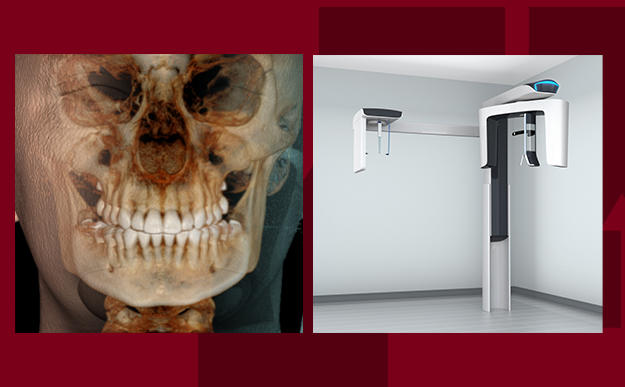Investing in digital dentistry through Cone Beam CT technology

The School of Dentistry has made a major investment in the future of 3D imaging, thanks to the work of two faculty specialists. Now, they are on a mission to educate more dental professionals in the process.
Laurence Gaalaas, DDS, MS, is a clinical assistant professor in the Division of Oral Medicine, Diagnosis, and Radiology. Mansur Ahmad, PhD, is an associate professor in the same division. The two are the only maxillofacial radiologists in the state of Minnesota. They spend their time teaching, reviewing radiographic images in clinics and researching. Most recently, the two have been implementing a new PACS image organization system at the school and coordinating the use of several Cone Beam CT units throughout the School of Dentistry.
“We have units in our radiology clinic and orthodontics clinic that are capable of scanning the entire face and skull. These images are great for planning surgery, evaluating pathology, and orthodontic diagnosis,” Gaalaas explained. “We also have a separate unit in our endodontics clinic that scans just a few teeth at high resolution to look at very small tooth features, plus a dedicated medium field of view unit in prosthodontics for planning implant surgeries”
These 3D scanning systems have “helped basically every area of dentistry make better treatment decisions,” Gaalaas shared.
The investment in new cone beam technology, combined with the use of the new organizational software, will significantly improve the School’s ability to provide robust patient care within and throughout School of Dentistry clinics. “I am most excited when I consider the possibilities as we evolve to more digital dental care,” Gaalaas reflected. “With this new system, if a patient has a CBCT scan in orthodontics and years later needs a new crown or tooth replaced by our prosthodontics providers, we can very easily locate those prior scans no matter where or when they were taken, and then use that information to digitally plan for the new crown, restoration, or implant, all in a fraction of the time and effort it takes using analog plaster-based laboratory techniques.”
Ahmad is especially proud of the way that CBCT imaging has improved patient care and how he and Gaalaas have worked hard to prepare students for what he considers an “essential tool in their practice.”
Ahmad and Gaalaas work together to educate dental hygiene, DDS, advanced education, Dental Therapy, UMN PASS and Continuing Dental Education students in the tool’s use, continually revising their teaching standards. “Each year, we introduce more CBCT cases, and we’ve expanded our seminars and 3D teaching,” Gaalaas explained. “We’ve taken a critical eye to our teaching and make sure it’s patient focused.”
That focus on continually improving education flows into Continuing Dental Education, too. Mansur and Ahmad are hosting a mini residency on Cone Beam Imaging in November. They’re excited to introduce more dental practices to the use of this effective, seamless diagnostic tool.
“Our course draws national and international demand because we offer one of the very few multi-day, hands-on CBCT courses in the country. We believe strongly that for our attendees to begin learning the strategies for interpreting and reviewing these scans, they must have substantial hands-on experience under the supervision of a qualified instructor,” Gaalaas explained. That is precisely what he and Ahmad aim to do during their two-day mini-residency.
“We cannot turn our students into radiologists in just a few days, but we can give them the tools to get started with CBCT in their own practices, and the resources to find answers when they need them. it.”
Holding the titles of the only oral and maxillofacial radiologists in the state training oral health professionals to use this new and high-resolution technology is a tough job, but Ahmad and Gaalaas are up for it - and they are excited to continue making dentistry better. “Compared to conventional 2D radiography, CBCT eliminates a lot of guess work and clarifies patient scenarios that in the past left more questions than answers.”
Learn more about the upcoming mini-registry, and register today for the limited-attendance experience.